Systems Theories in Psychology: Analyzing Harry and Caroline's Cases
VerifiedAdded on 2023/01/04
|7
|1933
|91
Report
AI Summary
This report examines the application of two systems theories—complex adaptive systems and integral theory—to the case studies of Harry and Caroline, members of the Morgan family. It begins by introducing complex adaptive systems theory and its relevance to Harry, a child with learning disabilities and emotional/behavioral difficulties, emphasizing the benefits of this model in providing appropriate care and support. The report then describes integral theory and its application to Caroline, the eldest child, who takes on significant responsibilities due to her parents' challenges. It evaluates the benefits and limitations of each theory in relation to both Harry and Caroline, highlighting how these models can inform social work practices and improve understanding of complex family dynamics. The conclusion summarizes the effectiveness of these systems theories in assessing and addressing the needs of individuals within their family and societal contexts, emphasizing their value in providing appropriate care and support.
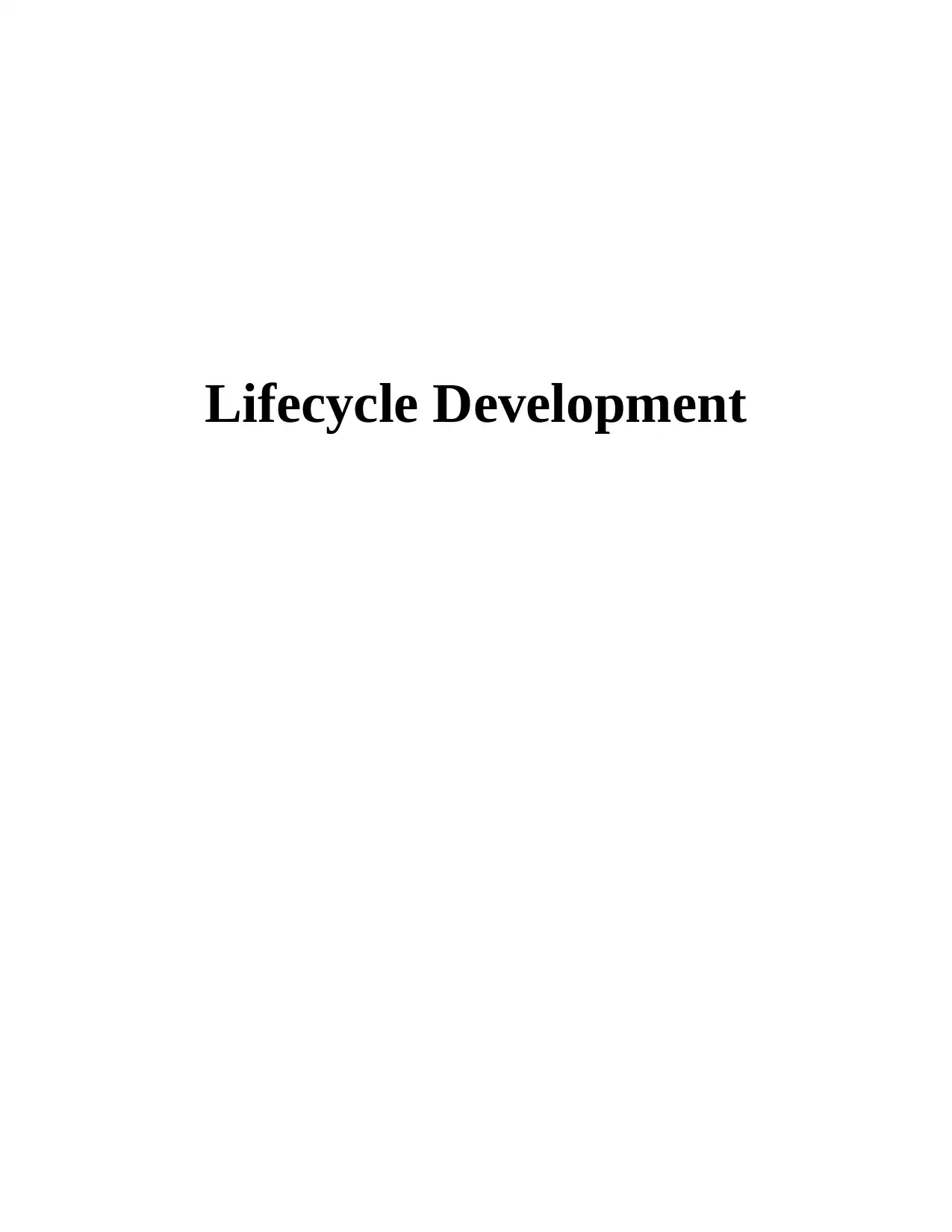
Lifecycle Development
Paraphrase This Document
Need a fresh take? Get an instant paraphrase of this document with our AI Paraphraser
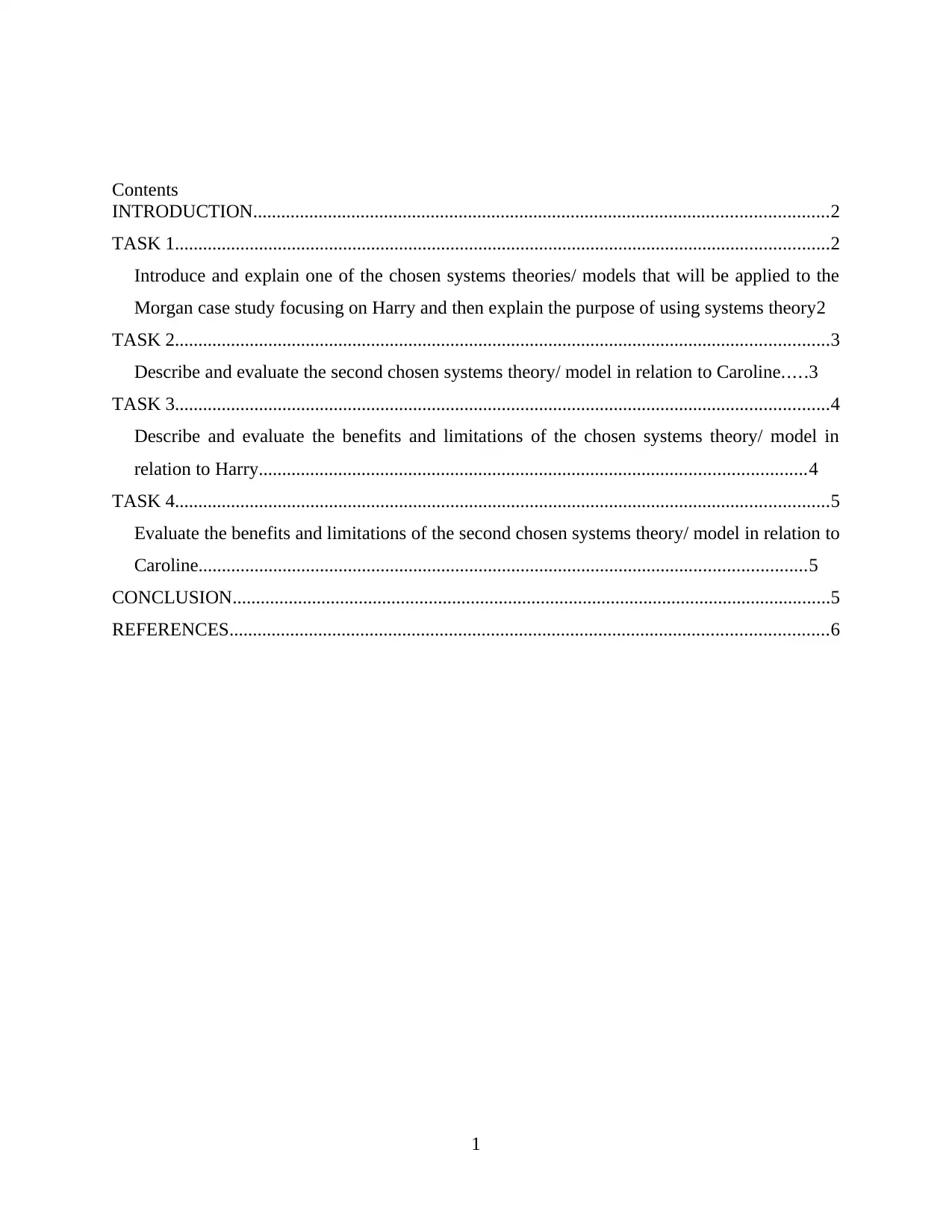
Contents
INTRODUCTION...........................................................................................................................2
TASK 1............................................................................................................................................2
Introduce and explain one of the chosen systems theories/ models that will be applied to the
Morgan case study focusing on Harry and then explain the purpose of using systems theory2
TASK 2............................................................................................................................................3
Describe and evaluate the second chosen systems theory/ model in relation to Caroline.....3
TASK 3............................................................................................................................................4
Describe and evaluate the benefits and limitations of the chosen systems theory/ model in
relation to Harry.....................................................................................................................4
TASK 4............................................................................................................................................5
Evaluate the benefits and limitations of the second chosen systems theory/ model in relation to
Caroline..................................................................................................................................5
CONCLUSION................................................................................................................................5
REFERENCES................................................................................................................................6
1
INTRODUCTION...........................................................................................................................2
TASK 1............................................................................................................................................2
Introduce and explain one of the chosen systems theories/ models that will be applied to the
Morgan case study focusing on Harry and then explain the purpose of using systems theory2
TASK 2............................................................................................................................................3
Describe and evaluate the second chosen systems theory/ model in relation to Caroline.....3
TASK 3............................................................................................................................................4
Describe and evaluate the benefits and limitations of the chosen systems theory/ model in
relation to Harry.....................................................................................................................4
TASK 4............................................................................................................................................5
Evaluate the benefits and limitations of the second chosen systems theory/ model in relation to
Caroline..................................................................................................................................5
CONCLUSION................................................................................................................................5
REFERENCES................................................................................................................................6
1
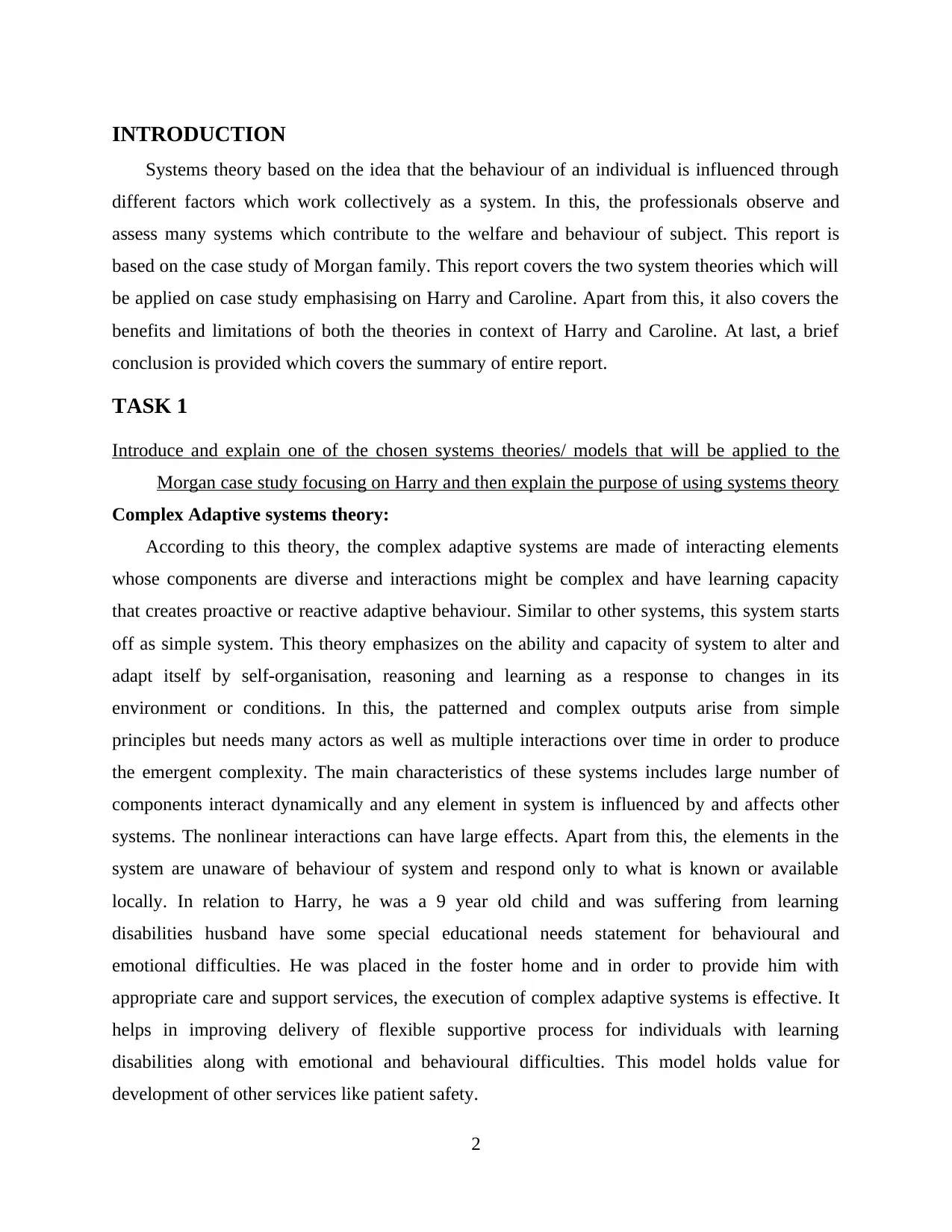
INTRODUCTION
Systems theory based on the idea that the behaviour of an individual is influenced through
different factors which work collectively as a system. In this, the professionals observe and
assess many systems which contribute to the welfare and behaviour of subject. This report is
based on the case study of Morgan family. This report covers the two system theories which will
be applied on case study emphasising on Harry and Caroline. Apart from this, it also covers the
benefits and limitations of both the theories in context of Harry and Caroline. At last, a brief
conclusion is provided which covers the summary of entire report.
TASK 1
Introduce and explain one of the chosen systems theories/ models that will be applied to the
Morgan case study focusing on Harry and then explain the purpose of using systems theory
Complex Adaptive systems theory:
According to this theory, the complex adaptive systems are made of interacting elements
whose components are diverse and interactions might be complex and have learning capacity
that creates proactive or reactive adaptive behaviour. Similar to other systems, this system starts
off as simple system. This theory emphasizes on the ability and capacity of system to alter and
adapt itself by self-organisation, reasoning and learning as a response to changes in its
environment or conditions. In this, the patterned and complex outputs arise from simple
principles but needs many actors as well as multiple interactions over time in order to produce
the emergent complexity. The main characteristics of these systems includes large number of
components interact dynamically and any element in system is influenced by and affects other
systems. The nonlinear interactions can have large effects. Apart from this, the elements in the
system are unaware of behaviour of system and respond only to what is known or available
locally. In relation to Harry, he was a 9 year old child and was suffering from learning
disabilities husband have some special educational needs statement for behavioural and
emotional difficulties. He was placed in the foster home and in order to provide him with
appropriate care and support services, the execution of complex adaptive systems is effective. It
helps in improving delivery of flexible supportive process for individuals with learning
disabilities along with emotional and behavioural difficulties. This model holds value for
development of other services like patient safety.
2
Systems theory based on the idea that the behaviour of an individual is influenced through
different factors which work collectively as a system. In this, the professionals observe and
assess many systems which contribute to the welfare and behaviour of subject. This report is
based on the case study of Morgan family. This report covers the two system theories which will
be applied on case study emphasising on Harry and Caroline. Apart from this, it also covers the
benefits and limitations of both the theories in context of Harry and Caroline. At last, a brief
conclusion is provided which covers the summary of entire report.
TASK 1
Introduce and explain one of the chosen systems theories/ models that will be applied to the
Morgan case study focusing on Harry and then explain the purpose of using systems theory
Complex Adaptive systems theory:
According to this theory, the complex adaptive systems are made of interacting elements
whose components are diverse and interactions might be complex and have learning capacity
that creates proactive or reactive adaptive behaviour. Similar to other systems, this system starts
off as simple system. This theory emphasizes on the ability and capacity of system to alter and
adapt itself by self-organisation, reasoning and learning as a response to changes in its
environment or conditions. In this, the patterned and complex outputs arise from simple
principles but needs many actors as well as multiple interactions over time in order to produce
the emergent complexity. The main characteristics of these systems includes large number of
components interact dynamically and any element in system is influenced by and affects other
systems. The nonlinear interactions can have large effects. Apart from this, the elements in the
system are unaware of behaviour of system and respond only to what is known or available
locally. In relation to Harry, he was a 9 year old child and was suffering from learning
disabilities husband have some special educational needs statement for behavioural and
emotional difficulties. He was placed in the foster home and in order to provide him with
appropriate care and support services, the execution of complex adaptive systems is effective. It
helps in improving delivery of flexible supportive process for individuals with learning
disabilities along with emotional and behavioural difficulties. This model holds value for
development of other services like patient safety.
2
⊘ This is a preview!⊘
Do you want full access?
Subscribe today to unlock all pages.

Trusted by 1+ million students worldwide
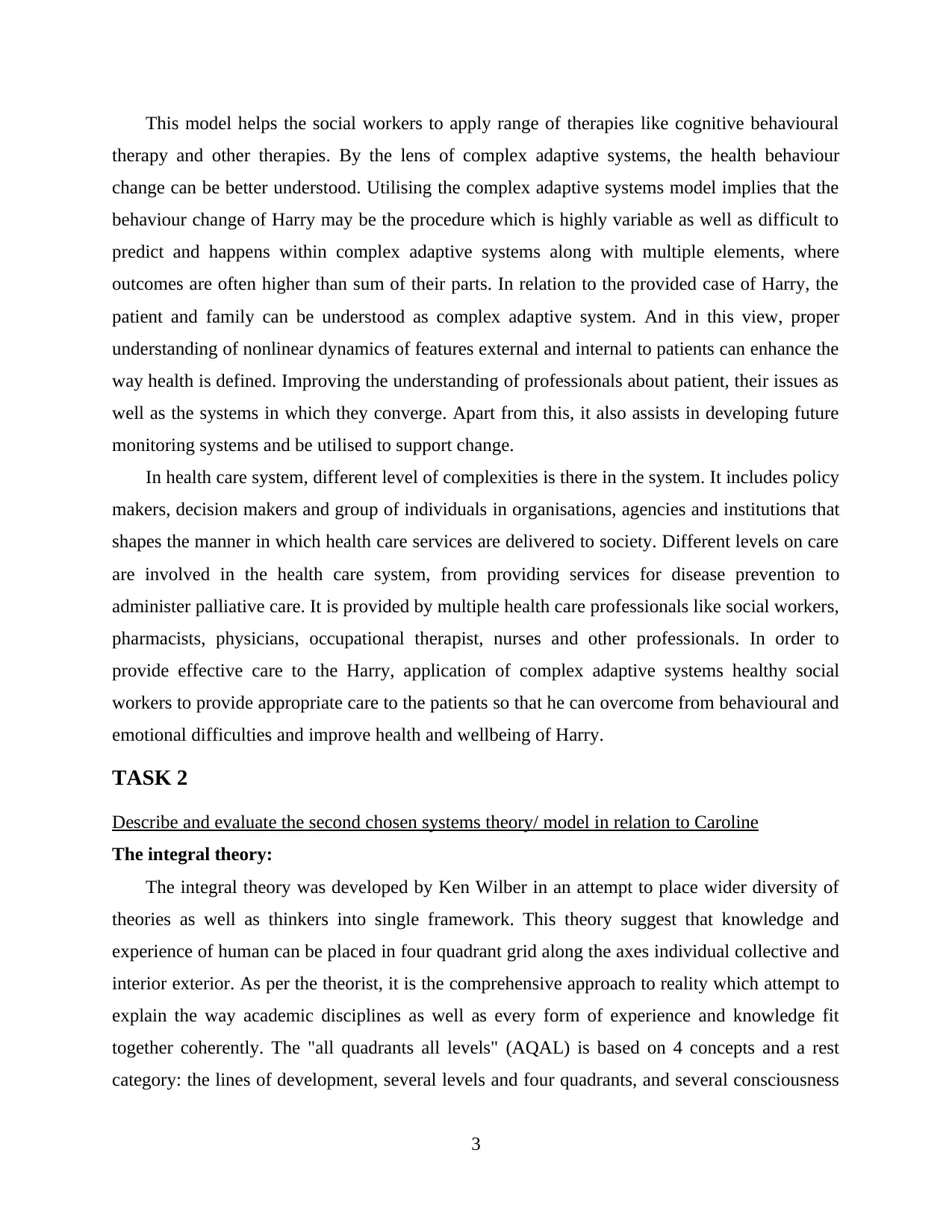
This model helps the social workers to apply range of therapies like cognitive behavioural
therapy and other therapies. By the lens of complex adaptive systems, the health behaviour
change can be better understood. Utilising the complex adaptive systems model implies that the
behaviour change of Harry may be the procedure which is highly variable as well as difficult to
predict and happens within complex adaptive systems along with multiple elements, where
outcomes are often higher than sum of their parts. In relation to the provided case of Harry, the
patient and family can be understood as complex adaptive system. And in this view, proper
understanding of nonlinear dynamics of features external and internal to patients can enhance the
way health is defined. Improving the understanding of professionals about patient, their issues as
well as the systems in which they converge. Apart from this, it also assists in developing future
monitoring systems and be utilised to support change.
In health care system, different level of complexities is there in the system. It includes policy
makers, decision makers and group of individuals in organisations, agencies and institutions that
shapes the manner in which health care services are delivered to society. Different levels on care
are involved in the health care system, from providing services for disease prevention to
administer palliative care. It is provided by multiple health care professionals like social workers,
pharmacists, physicians, occupational therapist, nurses and other professionals. In order to
provide effective care to the Harry, application of complex adaptive systems healthy social
workers to provide appropriate care to the patients so that he can overcome from behavioural and
emotional difficulties and improve health and wellbeing of Harry.
TASK 2
Describe and evaluate the second chosen systems theory/ model in relation to Caroline
The integral theory:
The integral theory was developed by Ken Wilber in an attempt to place wider diversity of
theories as well as thinkers into single framework. This theory suggest that knowledge and
experience of human can be placed in four quadrant grid along the axes individual collective and
interior exterior. As per the theorist, it is the comprehensive approach to reality which attempt to
explain the way academic disciplines as well as every form of experience and knowledge fit
together coherently. The "all quadrants all levels" (AQAL) is based on 4 concepts and a rest
category: the lines of development, several levels and four quadrants, and several consciousness
3
therapy and other therapies. By the lens of complex adaptive systems, the health behaviour
change can be better understood. Utilising the complex adaptive systems model implies that the
behaviour change of Harry may be the procedure which is highly variable as well as difficult to
predict and happens within complex adaptive systems along with multiple elements, where
outcomes are often higher than sum of their parts. In relation to the provided case of Harry, the
patient and family can be understood as complex adaptive system. And in this view, proper
understanding of nonlinear dynamics of features external and internal to patients can enhance the
way health is defined. Improving the understanding of professionals about patient, their issues as
well as the systems in which they converge. Apart from this, it also assists in developing future
monitoring systems and be utilised to support change.
In health care system, different level of complexities is there in the system. It includes policy
makers, decision makers and group of individuals in organisations, agencies and institutions that
shapes the manner in which health care services are delivered to society. Different levels on care
are involved in the health care system, from providing services for disease prevention to
administer palliative care. It is provided by multiple health care professionals like social workers,
pharmacists, physicians, occupational therapist, nurses and other professionals. In order to
provide effective care to the Harry, application of complex adaptive systems healthy social
workers to provide appropriate care to the patients so that he can overcome from behavioural and
emotional difficulties and improve health and wellbeing of Harry.
TASK 2
Describe and evaluate the second chosen systems theory/ model in relation to Caroline
The integral theory:
The integral theory was developed by Ken Wilber in an attempt to place wider diversity of
theories as well as thinkers into single framework. This theory suggest that knowledge and
experience of human can be placed in four quadrant grid along the axes individual collective and
interior exterior. As per the theorist, it is the comprehensive approach to reality which attempt to
explain the way academic disciplines as well as every form of experience and knowledge fit
together coherently. The "all quadrants all levels" (AQAL) is based on 4 concepts and a rest
category: the lines of development, several levels and four quadrants, and several consciousness
3
Paraphrase This Document
Need a fresh take? Get an instant paraphrase of this document with our AI Paraphraser
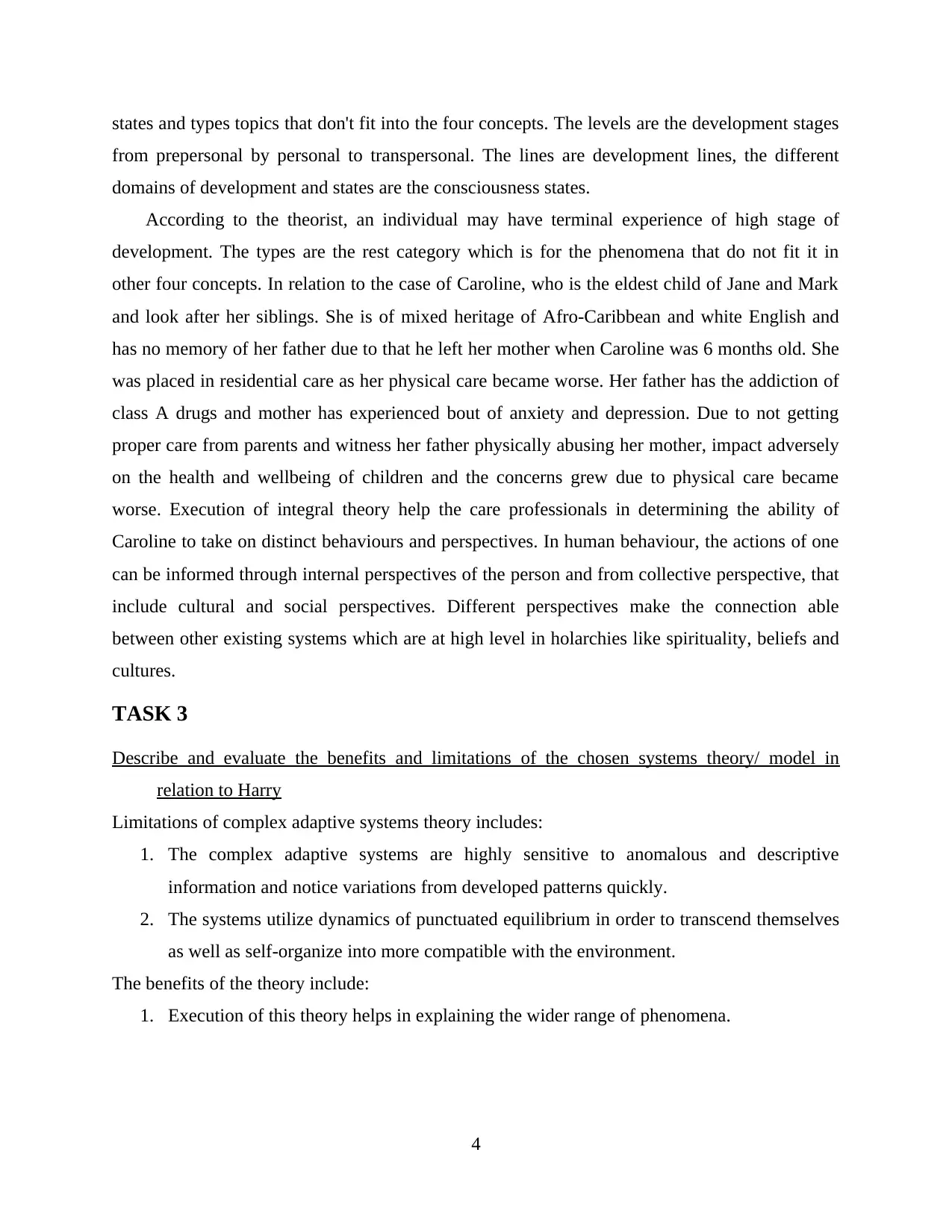
states and types topics that don't fit into the four concepts. The levels are the development stages
from prepersonal by personal to transpersonal. The lines are development lines, the different
domains of development and states are the consciousness states.
According to the theorist, an individual may have terminal experience of high stage of
development. The types are the rest category which is for the phenomena that do not fit it in
other four concepts. In relation to the case of Caroline, who is the eldest child of Jane and Mark
and look after her siblings. She is of mixed heritage of Afro-Caribbean and white English and
has no memory of her father due to that he left her mother when Caroline was 6 months old. She
was placed in residential care as her physical care became worse. Her father has the addiction of
class A drugs and mother has experienced bout of anxiety and depression. Due to not getting
proper care from parents and witness her father physically abusing her mother, impact adversely
on the health and wellbeing of children and the concerns grew due to physical care became
worse. Execution of integral theory help the care professionals in determining the ability of
Caroline to take on distinct behaviours and perspectives. In human behaviour, the actions of one
can be informed through internal perspectives of the person and from collective perspective, that
include cultural and social perspectives. Different perspectives make the connection able
between other existing systems which are at high level in holarchies like spirituality, beliefs and
cultures.
TASK 3
Describe and evaluate the benefits and limitations of the chosen systems theory/ model in
relation to Harry
Limitations of complex adaptive systems theory includes:
1. The complex adaptive systems are highly sensitive to anomalous and descriptive
information and notice variations from developed patterns quickly.
2. The systems utilize dynamics of punctuated equilibrium in order to transcend themselves
as well as self-organize into more compatible with the environment.
The benefits of the theory include:
1. Execution of this theory helps in explaining the wider range of phenomena.
4
from prepersonal by personal to transpersonal. The lines are development lines, the different
domains of development and states are the consciousness states.
According to the theorist, an individual may have terminal experience of high stage of
development. The types are the rest category which is for the phenomena that do not fit it in
other four concepts. In relation to the case of Caroline, who is the eldest child of Jane and Mark
and look after her siblings. She is of mixed heritage of Afro-Caribbean and white English and
has no memory of her father due to that he left her mother when Caroline was 6 months old. She
was placed in residential care as her physical care became worse. Her father has the addiction of
class A drugs and mother has experienced bout of anxiety and depression. Due to not getting
proper care from parents and witness her father physically abusing her mother, impact adversely
on the health and wellbeing of children and the concerns grew due to physical care became
worse. Execution of integral theory help the care professionals in determining the ability of
Caroline to take on distinct behaviours and perspectives. In human behaviour, the actions of one
can be informed through internal perspectives of the person and from collective perspective, that
include cultural and social perspectives. Different perspectives make the connection able
between other existing systems which are at high level in holarchies like spirituality, beliefs and
cultures.
TASK 3
Describe and evaluate the benefits and limitations of the chosen systems theory/ model in
relation to Harry
Limitations of complex adaptive systems theory includes:
1. The complex adaptive systems are highly sensitive to anomalous and descriptive
information and notice variations from developed patterns quickly.
2. The systems utilize dynamics of punctuated equilibrium in order to transcend themselves
as well as self-organize into more compatible with the environment.
The benefits of the theory include:
1. Execution of this theory helps in explaining the wider range of phenomena.
4
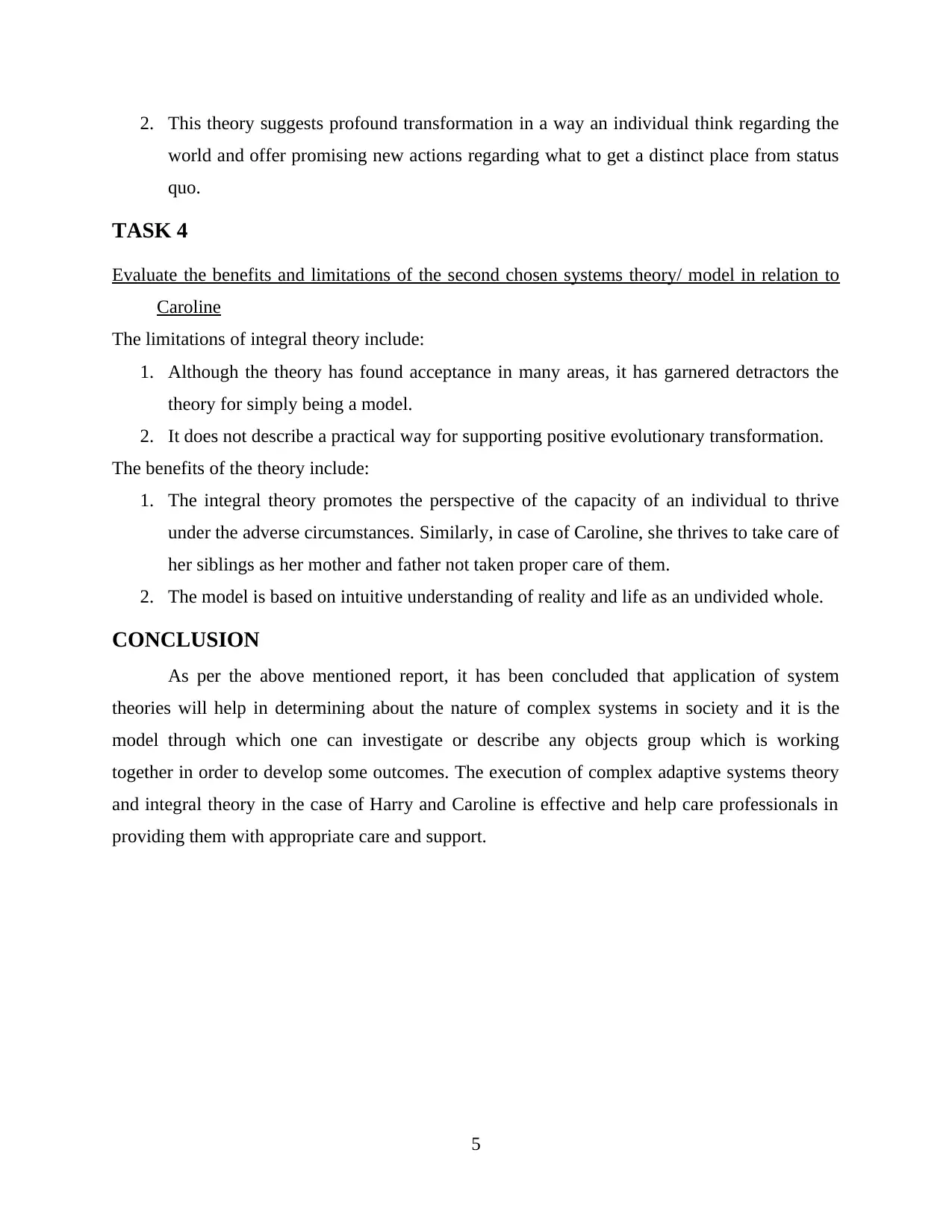
2. This theory suggests profound transformation in a way an individual think regarding the
world and offer promising new actions regarding what to get a distinct place from status
quo.
TASK 4
Evaluate the benefits and limitations of the second chosen systems theory/ model in relation to
Caroline
The limitations of integral theory include:
1. Although the theory has found acceptance in many areas, it has garnered detractors the
theory for simply being a model.
2. It does not describe a practical way for supporting positive evolutionary transformation.
The benefits of the theory include:
1. The integral theory promotes the perspective of the capacity of an individual to thrive
under the adverse circumstances. Similarly, in case of Caroline, she thrives to take care of
her siblings as her mother and father not taken proper care of them.
2. The model is based on intuitive understanding of reality and life as an undivided whole.
CONCLUSION
As per the above mentioned report, it has been concluded that application of system
theories will help in determining about the nature of complex systems in society and it is the
model through which one can investigate or describe any objects group which is working
together in order to develop some outcomes. The execution of complex adaptive systems theory
and integral theory in the case of Harry and Caroline is effective and help care professionals in
providing them with appropriate care and support.
5
world and offer promising new actions regarding what to get a distinct place from status
quo.
TASK 4
Evaluate the benefits and limitations of the second chosen systems theory/ model in relation to
Caroline
The limitations of integral theory include:
1. Although the theory has found acceptance in many areas, it has garnered detractors the
theory for simply being a model.
2. It does not describe a practical way for supporting positive evolutionary transformation.
The benefits of the theory include:
1. The integral theory promotes the perspective of the capacity of an individual to thrive
under the adverse circumstances. Similarly, in case of Caroline, she thrives to take care of
her siblings as her mother and father not taken proper care of them.
2. The model is based on intuitive understanding of reality and life as an undivided whole.
CONCLUSION
As per the above mentioned report, it has been concluded that application of system
theories will help in determining about the nature of complex systems in society and it is the
model through which one can investigate or describe any objects group which is working
together in order to develop some outcomes. The execution of complex adaptive systems theory
and integral theory in the case of Harry and Caroline is effective and help care professionals in
providing them with appropriate care and support.
5
⊘ This is a preview!⊘
Do you want full access?
Subscribe today to unlock all pages.

Trusted by 1+ million students worldwide
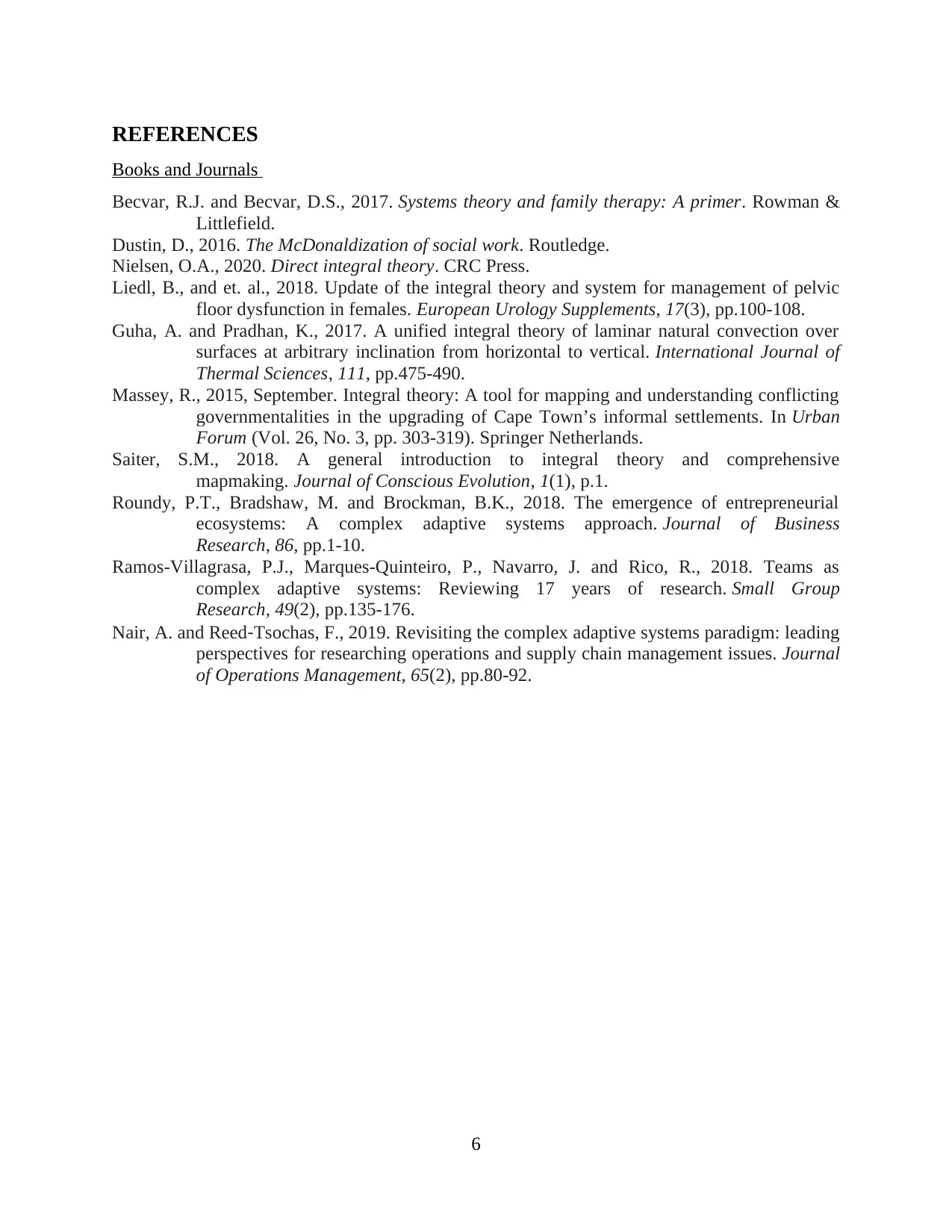
REFERENCES
Books and Journals
Becvar, R.J. and Becvar, D.S., 2017. Systems theory and family therapy: A primer. Rowman &
Littlefield.
Dustin, D., 2016. The McDonaldization of social work. Routledge.
Nielsen, O.A., 2020. Direct integral theory. CRC Press.
Liedl, B., and et. al., 2018. Update of the integral theory and system for management of pelvic
floor dysfunction in females. European Urology Supplements, 17(3), pp.100-108.
Guha, A. and Pradhan, K., 2017. A unified integral theory of laminar natural convection over
surfaces at arbitrary inclination from horizontal to vertical. International Journal of
Thermal Sciences, 111, pp.475-490.
Massey, R., 2015, September. Integral theory: A tool for mapping and understanding conflicting
governmentalities in the upgrading of Cape Town’s informal settlements. In Urban
Forum (Vol. 26, No. 3, pp. 303-319). Springer Netherlands.
Saiter, S.M., 2018. A general introduction to integral theory and comprehensive
mapmaking. Journal of Conscious Evolution, 1(1), p.1.
Roundy, P.T., Bradshaw, M. and Brockman, B.K., 2018. The emergence of entrepreneurial
ecosystems: A complex adaptive systems approach. Journal of Business
Research, 86, pp.1-10.
Ramos-Villagrasa, P.J., Marques-Quinteiro, P., Navarro, J. and Rico, R., 2018. Teams as
complex adaptive systems: Reviewing 17 years of research. Small Group
Research, 49(2), pp.135-176.
Nair, A. and Reed‐Tsochas, F., 2019. Revisiting the complex adaptive systems paradigm: leading
perspectives for researching operations and supply chain management issues. Journal
of Operations Management, 65(2), pp.80-92.
6
Books and Journals
Becvar, R.J. and Becvar, D.S., 2017. Systems theory and family therapy: A primer. Rowman &
Littlefield.
Dustin, D., 2016. The McDonaldization of social work. Routledge.
Nielsen, O.A., 2020. Direct integral theory. CRC Press.
Liedl, B., and et. al., 2018. Update of the integral theory and system for management of pelvic
floor dysfunction in females. European Urology Supplements, 17(3), pp.100-108.
Guha, A. and Pradhan, K., 2017. A unified integral theory of laminar natural convection over
surfaces at arbitrary inclination from horizontal to vertical. International Journal of
Thermal Sciences, 111, pp.475-490.
Massey, R., 2015, September. Integral theory: A tool for mapping and understanding conflicting
governmentalities in the upgrading of Cape Town’s informal settlements. In Urban
Forum (Vol. 26, No. 3, pp. 303-319). Springer Netherlands.
Saiter, S.M., 2018. A general introduction to integral theory and comprehensive
mapmaking. Journal of Conscious Evolution, 1(1), p.1.
Roundy, P.T., Bradshaw, M. and Brockman, B.K., 2018. The emergence of entrepreneurial
ecosystems: A complex adaptive systems approach. Journal of Business
Research, 86, pp.1-10.
Ramos-Villagrasa, P.J., Marques-Quinteiro, P., Navarro, J. and Rico, R., 2018. Teams as
complex adaptive systems: Reviewing 17 years of research. Small Group
Research, 49(2), pp.135-176.
Nair, A. and Reed‐Tsochas, F., 2019. Revisiting the complex adaptive systems paradigm: leading
perspectives for researching operations and supply chain management issues. Journal
of Operations Management, 65(2), pp.80-92.
6
1 out of 7
Related Documents
Your All-in-One AI-Powered Toolkit for Academic Success.
+13062052269
info@desklib.com
Available 24*7 on WhatsApp / Email
![[object Object]](/_next/static/media/star-bottom.7253800d.svg)
Unlock your academic potential
Copyright © 2020–2025 A2Z Services. All Rights Reserved. Developed and managed by ZUCOL.




